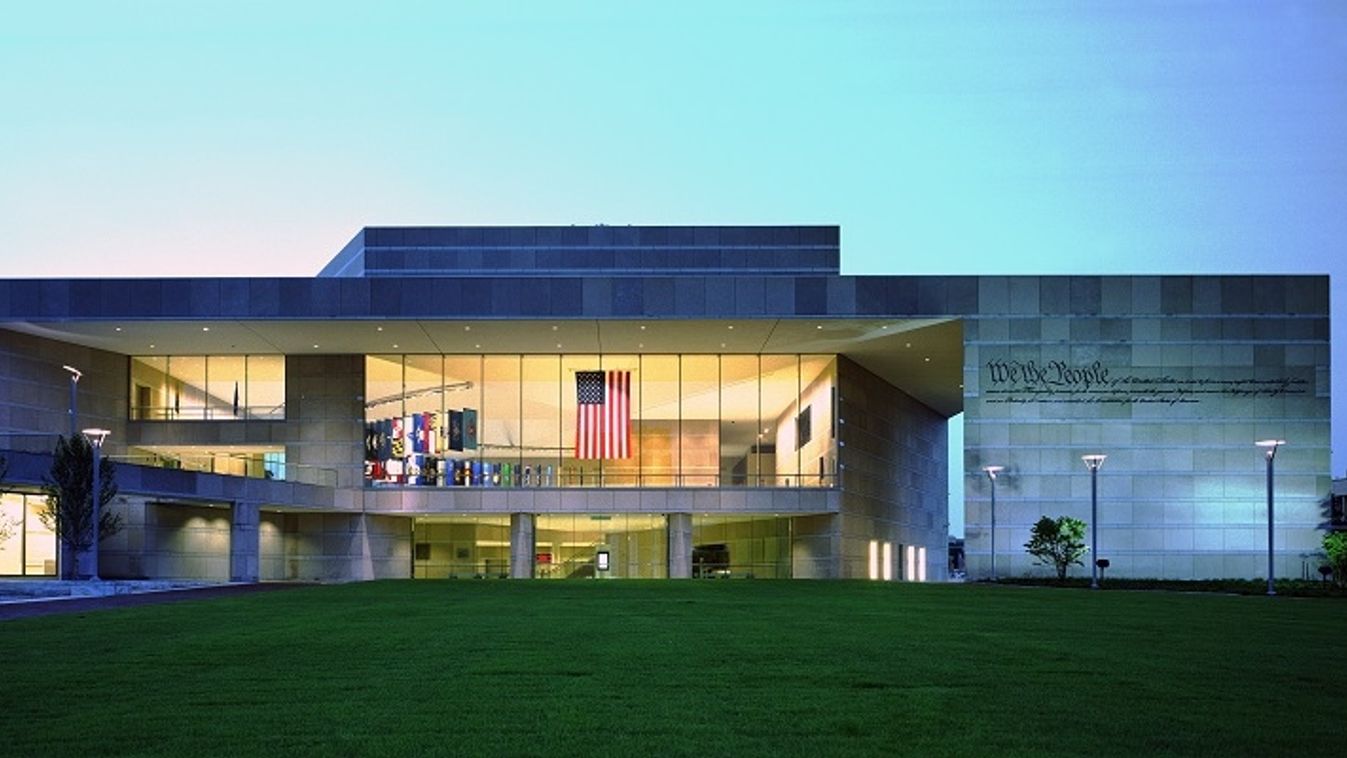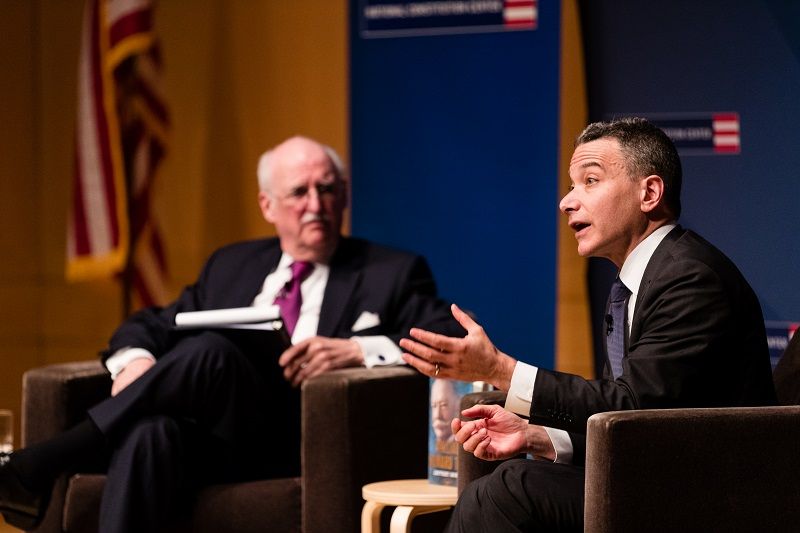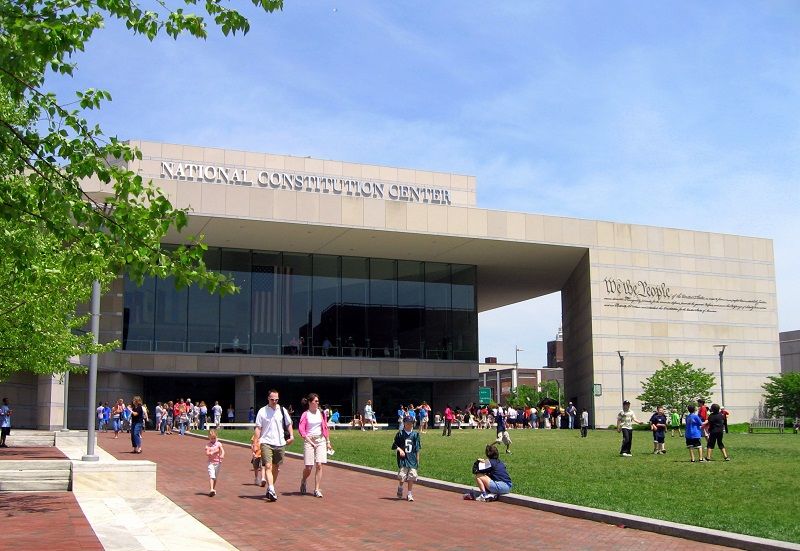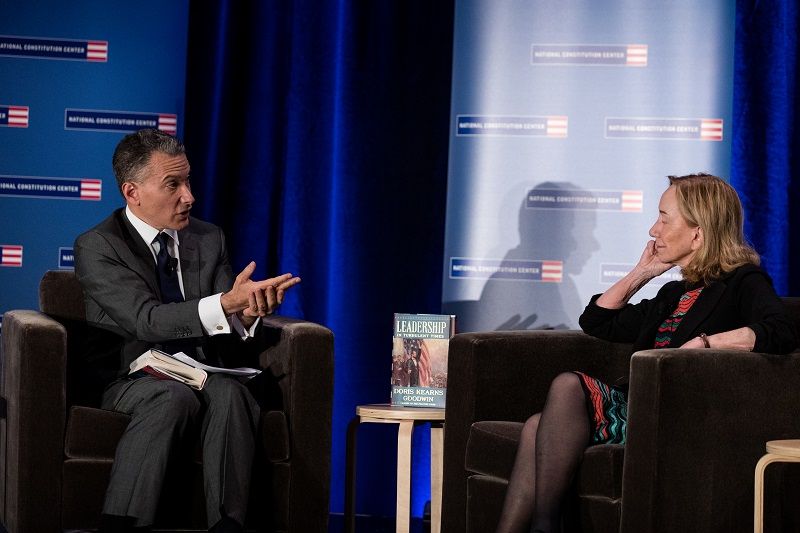Félelem és rettegés lett úrrá Brüsszelen: Orbán Viktor barátja lassan beveszi Bécset

Elképesztő fölényben az Osztrák Szabadságpárt.

Lénárd Sándor, researcher at the American Studies Research Institute of the National University of Public Service, located in Budapest, Hungary spoke with Professor Jeffrey Rosen, president of the National Constitution Center, professor of law at George Washington University and one of the leading constitutional scholars of America about the establishment and mission of the National Constitution Center; about the role of the U.S. Supreme Court in an increasingly polarized America, and about what the American experience on judicial activism is revealing. In the course of the conversation they also touched upon recent constitutional dilemmas brought by the digital era along with contemporary constitutional challenges around the world.

Lénárd Sándor: First of all, I would like to mention that Philadelphia is amongst the most historic cities of the United States that gives home to Independence Hall, the First and Second Banks of the United States and Christ Church that the Founders used to attend. The city was the birthplace of a new country since the Declaration of Independence that was formulated, debated and adopted there. In addition, the city is also the home of a young but nevertheless quite active institution, the National Constitution Center that enjoys increasing popularity. I am talking to Professor Jeffrey Rosen, president of this institution and my very first question is what was the driving force behind establishing such an institution?
Jeffrey Rosen: Well, it was a brief shining moment during the bicentennial of the U.S. Constitution that a bipartisan majority in Congress decided to create a National Constitution Center. Its inspiring mission is “to disseminate information about the Constitution on a non-partisan basis in order to increase awareness and understanding of the Constitution among the American people.” It was remarkable that Democrats and Republicans were able to come together to create this private and non-profit institution with an inspiring public charter. The money was raised partly from the federal government but also from private philanthropists and the Center opened its doors in 2004. It is hard to imagine Congress converging around this inspiring center for non-partisan constitutional education today. It is wonderful that America thought it was important while celebrating our 200th anniversary to create this educational institution.

L. S.: This is truly inspiring and as I understand the mission of this institution is to educate Americans about the Constitution and the culture of constitutionalism. I would be very interested in what major avenues you are using to facilitate the dissemination of information about the Constitution. How can the Center bring the Constitution closer to the people?
J. R.: We fulfill our educational mission in three major ways: as the museum of “We the People”, as America’s Town Hall center for constitutional debate and as America’s leading center for civic education. The Museum of “We the People” is the beautiful building designed by I.M. Pei (Ieoh Ming Pei) with live theatrical experiences about the Constitution with the five rarest drafts of the U.S. Constitution ever written, including James Wilson’s original draft along with one of the twelve original copies of the Bill of Rights and with exciting programs for students of all ages. We also hold public programs which we call town hall programs in Philadelphia and across America. These programs are all distributed on-line. In addition, I host weekly a podcast, “We The People,” which unites the top conservative and liberal scholars in America to debate constitutional issues in the news ranging from “can the President declare national emergency to build a border wall” to “should the Equal Rights Amendment be ratified and could it be ratified belatedly?” Finally, we are America’s center for civic education. Here the hub of our efforts is the online interactive constitution. Learners from across America and around the world can access this on-line platform that has had twenty million hits since it was launched in 2015. The centerpieces of the interactive constitution are essays written by both conservative and liberal scholars across America.
The National Constitution Center has convened the conservative Federalist Society and the progressive American Constitution Society, the leading conservative and liberal lawyers’ organizations in America to nominate scholars to write about every clause of the Constitution describing what they agree and what they disagree about them. It is thrilling to be able to click on the Second Amendment about the right to bear firearms and to see a thousand words from the leading conservative and liberal Second Amendment scholars about what they agree the core meaning of the Amendment is. In this way it is similar to a unanimous Supreme Court opinion and every word in that statement is agreed to by both sides. There are also separate statements like concurring or dissenting opinions. Multiplied that by all eighty clauses of the Constitution and there is a Constitutional feast, a thrilling font of constitutional knowledge which instructs and illuminates everyone. In addition, this platform also hosts videos about the Constitution with Supreme Court Justices; and it includes lessons for schoolkids in both middle schools and high schools, it includes the ability to explore the text of each clause of the Constitution and its antecedents. If you click on the Bill of Rights, you can see the Revolutionary Era State constitutions that James Madison cut and pasted from when he drafted the Bill of Rights. You can also do that for every provision of the Constitution as well. Finally, the most innovative part of the platform is where it hosts constitutional exchanges that unite classrooms across America from Philadelphia to California and from Kentucky to Ohio. There are students in different classrooms having constitutional conversations moderated by a judge or a master teacher. We are hoping to expand this experience to include citizens from red and blue America as well to promote civil dialogue.
Finally, this platform collects all of our public programs; the podcasts, the videos and the blogs so when you click on the First Amendment, you can find all the public programs and blogs associated with it. As people increasingly learn on-line, integrating all of our educational materials and public programs on this platform and pushing them out through all channels is very meaningful. We have collaborations with leading American educational institutions that are reaching millions of students through this great project. The main thing I need to stress about all of these projects -- the museum, the public programs and the educational initiatives -- is that they are non-partisan or multipartisan. Each of them convenes thought leaders and citizens with different perspectives, both conservatives and liberals, to explore areas of agreement and disagreement about the Constitution. We are the only institution in America that has an obligation to do that. These are extremely polarized times and both sides are rarely speaking to each other and therefore it is all the more meaningful and important to bring together people with different perspectives to debate not their policy views but their constitutional views. In other words, we ask citizens to ask not what they think the government should do but the what the Constitution allows it to do. Not whether gun control is a good or bad idea, for example, but whether the Second Amendment allows it or prohibits it. By asking people to separate their political from their constitutional views the same way that law professors ask their students to do that, and in a way that judges aspire to do, we hope to cultivate the habits of constitutional reasoning that will help people to elevate themselves above their partisan preferences to converge around this great document of human freedom.

J. R.: Most important when we guarantee neutrality is to host scholars with different perspectives nominated by the leading conservative and liberal lawyers’ groups. Therefore, the fact that so many of our public programs are cosponsored by the Federalist Society and the American Constitution Society guarantees neutrality since we can ensure that diversity of views are represented. Sometimes the two sides agree and sometimes they disagree, but we guarantee representing both perspectives. Now, some of the time we host a program with a liberal perspective and sometimes with a conservative one but overall, we seek balance. However, we do not shy away from expressing clear views in cases when the constitutional expectations are clear. For example, we can teach unequivocally when we teach about the First Amendment since our Supreme Court said repeatedly that speech in America can only be banned if it is intended to or likely to cause imminent violence. This is the standard that originates in the Whitney v. California and the Brandenburg v. Ohio cases. We are aware that it makes America an outlier when it comes to free speech protection in the world because this standard is far more speech-protective and protects even hate speech far more vigorously than other countries do. But because our Supreme Court has repeatedly reaffirmed this principle we can teach it without any embarrassment. We do not shy away from any subjects, but we only discuss them from a constitutional perspective and when there are multiple perspectives, we try to represent them in a balanced way.
L. S.: Speaking about the Supreme Court you are also a professor of law at George Washington University and author of several books on both the Supreme Court as an institution and on individual Justices of the Supreme Court. My favorite book of yours is the one in which you analyze the history of the Court through the lenses of conflicting judicial philosophies by comparing individual justices on the opposite ends of the ideological spectrum. In light of the major recent developments around the Supreme Court, both in terms of the outcomes of certain major cases as well as of the recent nomination and confirmation processes, it seems that the institution is increasingly drifting towards politicization. The Supreme Court also seems to play an increasingly larger role in shaping American constitutionalism and public policy questions. How do you see the current role of the Supreme Court in the governmental arrangement of the United States?
J. R.: As you rightly say the Supreme Court is at an inflection point. The legitimacy of all institutions of American government, like those of all institutions in general, are under siege in a polarized time and the Court has been through a series of unusually and increasingly polarized confirmation hearings. As a result, Chief Justice John Roberts along with other Associate Justices from both sides of the Court, have expressed concerns about citizens continued belief in the non-partisan legitimacy of the Supreme Court and the willingness to accept its decisions as being rooted in law rather than politics. Therefore, at the National Constitution Center we applaud the Chief Justice’s efforts to shore up the non-partisan legitimacy of the Court to defend judicial independence and to try to persuade his fellow justices to converge around opinions rather than dividing along partisan lines so cases are decided by bipartisan majorities. He has embraced as his model the greatest Chief Justice in America, John Marshall, who had a similarly fraught task at a time when the legitimacy of the court was under siege. Hence there is historical precedent for this. Chief Justice Roberts and all the Associate Justices are aware that this is a challenging time and we are doing everything we can to educate the public about the history and tradition of judicial review. Surveys show that citizens who know about the history of judicial review are more likely to support the Supreme Court’s ability to strike down unconstitutional laws while those who do not are more willing to overturn those decisions by popular vote. Politics is not a predictor here; it is constitutional education. This is the reason why it is so urgently important that we at the Center educate people about these histories and decisions so that they can accept the Courts as being based in law rather than politics.
L. S.: It is good that you mentioned John Marshall and the idea of judicial review. As I see it, the most important turning points in the history of the United States were about the distribution of powers between the member states and the federal government. We can very well think of John Marshall here but also of the debate between Alexander Hamilton and Thomas Jefferson; of the American Civil War itself; of the subsequent era of reconstruction and the amendments adopted in that era; and, last but not least, of the “Roosevelt revolution” along with the New Deal. These turning points all solidified the power of the federal government, in many cases at the expense of the member states regulatory autonomy. However, Federalism and the autonomy of member states are also part of the system of “checks and balances”. How do you see the role of the Supreme Court in this area? Does the Supreme Court see member states as reservoirs of sovereignty and does it attempt to defend their autonomies or rather sees them as agents of the Federal government whose roles have diminished to executing large federal programs and therefore the Court is less willing to protect their autonomies?
J. R.: You very well identified the periods of American history which could be considered as constitutional crises. If a constitutional crises is defined as a time when ordinary mechanisms for constitutional decision making break down and violence sometimes results, you rightly noted that the original ratification of the Constitution, the nullification crises leading up to the Civil War and the Post-civil War evisceration of the reconstruction amendments, as well as perhaps the New Deal crises, and then finally the civil rights movement might meet those criteria. All of those involved the vertical distribution of the power between national government versus the States. Broadly, Chief Justice John Marshall was an accolyte of national power espoused by Alexander Hamilton and by the forgotten but crucially important founder, James Wilson from Pennsylvania. It was Wilson who insisted that “We the People of the United States” as a whole have the sovereign power and not “We the People of individual states” and not the King or Parliament. It was Wilson’s insistence in locating sovereignty with the national people that Lincoln invoked when he denied the power of the South to secede because he said since “We the People of the Union” as a whole created the Union “We the people of the Union” as a whole would have to consent before the Union could be changed. Therefore, individual States had no sovereign power to leave. Marshall also said in his farewell address from Washington: in war we are one people, in making peace we are one people and in all commercial regulations we are one and the same people. It was interesting that Marshall established this nationalism in the context of not a vertical but a horizontal battle, namely with his archrival Thomas Jefferson. It was Marshall’s battle with Jefferson and his insistence that the Courts have the power to strike down unconstitutional laws even in the face of the president’s threats to ignore judicial decisions that shored up the legitimacy and power of the Court over the long run. Marshall’s two great battles are Marbury v. Madison which established judicial review and his opinions of upholding the constitutionality of the Bank of the United States. The great contribution of Marshall was not to butt his head up against the wall in sport as he famously put it. He asserted the power of the Court to strike down unconstitutional laws but refused to order the President to commit acts he feared the President might resist. He did not want to expose the Court as a paper tiger. The combination of this judicial statesmanship and this judicial strategic sense allowed him to commit acts that someone calls “judicial jujitsu”.

L. S.: As you brilliantly explained John Marshall’s genius elevated judicial review amongst the core principles of constitutionalism. However, there might also be a flip side of it when an increasingly activist judiciary pose a threat to democratic decision-making by stifling democratic deliberation. Increasingly vocal European critics point out that instead of remaining a check on the legislature, judicial activism becomes a driving force of social change. The United States also lived through such an era under Chief Justice Earl Warren in the 1960s. How do you see judicial activism in contemporary United States?
J. R.: This is an important debate what you have in Europe and understanding the two hundred years of American experience might be helpful. First of all, you cannot have a debate about activism without defining it. The most neutral definition is the one you used: it simply suggests that a decision to strike down a law is itself activist. Activism might be justified in a sense that the Constitution compels it, or it might be unjustified in a sense that the judges are inventing rights that cannot plausibly be inferred from the Constitution. Broadly the debate around activism in the United States began during the Progressive Era. The Supreme Court only struck down two federal laws between the decisions of Marbury v. Madison in 1803 and Dred Scott in 1857. It was not until the Progressive era that it began to strike down more state laws on the grounds that they violated economic liberty, and this culminated in the New Deal crises during which the Court invalidated a bunch of federal laws on the grounds that they violated economic liberty or separation of powers. In reaction to the New Deal, the Court stopped striking down laws on the basis of economic liberty but paid more attention to laws that threatened the liberties enumerated in the Bill of Rights. This led to the so called “Warren era” which critics claim is an example of the Court leading social change. Some scholars have a more complicated view and said the Court was actually acting as the partner of the President and Congress in most cases in the “Warren era” and not its antagonist, since it rarely enforced rights that the public and the other branches of the government did not support. Although the Court was quite activist and some of its decisions were controversial, it was not leading the rights’ revolution. Conservative critics disagree and say that the Warren Court, culminating in the Roe v. Wade decision which was decided after Chief Justice Earl Warren stepped down, made up rights that were not plausibly inferred from the Constitution.
Then we come to the “Rehnquist era” and then “Roberts era” when the shoes were on the other foot and the liberals claimed that the conservatives are the activists and they are the ones striking down laws ranging from the Citizens United campaign finance law to affirmative action programs and to the voting rights acts. Liberal justices led by the senior liberal Associate Justice Ruth Bader Ginsburg accused the conservatives of practicing the very judicial activism they used to forswear. Some conservatives now counter that what they call “judicial engagement” – which is another word for striking down laws – is appropriate when the courts are enforcing the separation of powers; that is, if one branch oversteps its limits, as they claimed that Congress did in passing the Affordable Care Act, and therefore they claim that striking the law down is permissible. Then, after the election of 2016, progressives began to rediscover the benefits of active judges who check Presidents who exceed their constitutional bounds. The debate about judicial restraint shifted to fervent pleas that the Court will keep both Congress and the President within their structurally appointed boundaries. All this suggests that we cannot separate activism from particular political issues that are being discussed at the moment. However, the American experience shows that judges have been on least solid ground when they have enforced rights with tenuous connection to the text and history of the Constitution and that do not have public support. Conversely, they have been on the strongest ground in cases in which they have done the opposite when they enforce pure constitutional principles against one branch that is obviously overstepping its boundaries, such as in the Steel Seizure Case (Youngstown Sheet & Tube Co. v. Sawyer, 1952) when the Supreme Court prevented President Harry S. Truman from seizing the steel mills under his Commander in Chief powers.

Jeffrey Rosen and Doris Kearns Goodwin
L. S.: I thank you for these quite exhaustive and instructive insights! Last but not least, I would like to touch upon a not less interesting and very modern dilemma by referring to your recent article “America’s living James Madison Nightmare”. In this article you are referring to unregulated media platforms that, instead of encouraging deliberations and profound engagements in public debate, rather become echo-chambers, constantly reinforcing political prejudices. Therefore, instead of increasing the quality of democratic deliberation they are actually eroding it. Do you think the traditional free speech principles should be reconsidered in light of this new technological development? Do you think that free speech shall come with greater responsibility in the digital era?
J. R.: I do not think the U.S. Supreme Court should reconsider its bedrock principle which represents the shining culmination of the American free speech tradition, namely that speech can only be banned if it is intended or likely to cause imminent violence. This principle, first articulated by James Madison and Thomas Jefferson in their opposition to the Sedition Act in 1798, was reinforced by Justice Louis Brandeis in his pathbreaking concurring opinion in the Whitney v. California case in 1927, and finally embraced by the U.S. Supreme Court in 1969 in the Brandenburg v. Ohio case. It represents the culmination of the Framers faith in reason rather than passion. They believed that as long as there is time enough for deliberation then the best response to hateful speech is good speech so that citizens can make up their own minds and reason can prevail. However, as you say, social media platforms have challenged that Madisonian faith and they sped up public deliberation to “warp speed” in a way that challenges Madison’s belief in the element of time and his conviction that only if people made decision slowly and over time could reason prevail. Madison was afraid of the demagogues and the mob, who he believed arise from direct democratic bodies like the Athenian Assembly, and that is why the whole American Constitution was designed to slow down deliberation. One cannot make quick votes here.
Therefore, Brexit would be inconceivable in the American Constitution because we do not allow for profound constitutional decision to be made on one-off national referenda. You need to jump through a lot of hoops until the US Constitution can be amended. Even to pass ordinary laws all three branches have to agree. Therefore, the speed with which speech travels on social media segregating itself in “echo-chambers” and “filter bubbles” is a real Madisonian problem. I do not think there is an easy solution to this problem. I do not think the best solution is regulation, and I am not totally convinced that government regulation of social media companies would really offer a solution to the problem because it is not clear to which direction one would regulate in order to promote more reasoned deliberations. Certainly, banning hate speech, as is common in Europe, has not begun to solve the problem in a non-deliberative or hasty and passionate on-line environment. There is another challenge that, as opposed to some European ones, the U.S. Constitution does not apply to private entities at all, including social-media platforms, as it says, “Congress shall make no law” and not Facebook shall make no law. You would have to have a Constitutional amendment regulating Facebook in order to apply free speech principles to the platforms. Although I am sympathetic to the idea that the platform should voluntarily embrace U.S. Constitutional principles, it is unlikely to happen in practice.
L. S.: In your opinion what are the most burning challenges ahead of the Supreme Court and of Constitutional Courts around the world today?
J. R.: I think the fact that so much of our lives takes place in spaces where the Constitution does not reach. It takes place on private platforms, which are often unregulated by the kinds of boundaries that constrain the government. And it is a dilemma that the courts cannot address on their own since they have no authority over the private companies that represent the spaces that determine the future of our speech and our privacy. There is no easy solution to this Madisonian problem. But there is one clear and urgent need and that is more constitutional education. Madison did say that the republic would collapse unless their citizens were educated in the science of government. This is the reason why the mission of the National Constitution Center is so urgently important and why constitutional education is key in addressing the constitutional challenges of our time. We believe that nothing less than the future of our republic is at stake and this is the reason why we are so passionate about the need to spread constitutional light to citizens of different backgrounds and to inspire people to educate themselves about the U.S. Constitution.
The interview is also available in Hungarian.